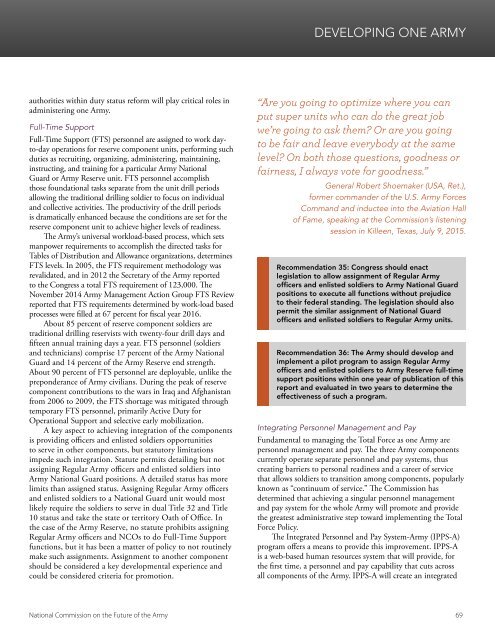THE FUTURE OF THE ARMY
NCFA_Full%20Final%20Report_0
NCFA_Full%20Final%20Report_0
Create successful ePaper yourself
Turn your PDF publications into a flip-book with our unique Google optimized e-Paper software.
DEVELOPING ONE <strong>ARMY</strong><br />
authorities within duty status reform will play critical roles in<br />
administering one Army.<br />
Full-Time Support<br />
Full-Time Support (FTS) personnel are assigned to work dayto-day<br />
operations for reserve component units, performing such<br />
duties as recruiting, organizing, administering, maintaining,<br />
instructing, and training for a particular Army National<br />
Guard or Army Reserve unit. FTS personnel accomplish<br />
those foundational tasks separate from the unit drill periods<br />
allowing the traditional drilling soldier to focus on individual<br />
and collective activities. The productivity of the drill periods<br />
is dramatically enhanced because the conditions are set for the<br />
reserve component unit to achieve higher levels of readiness.<br />
The Army’s universal workload-based process, which sets<br />
manpower requirements to accomplish the directed tasks for<br />
Tables of Distribution and Allowance organizations, determines<br />
FTS levels. In 2005, the FTS requirement methodology was<br />
revalidated, and in 2012 the Secretary of the Army reported<br />
to the Congress a total FTS requirement of 123,000. The<br />
November 2014 Army Management Action Group FTS Review<br />
reported that FTS requirements determined by work-load based<br />
processes were filled at 67 percent for fiscal year 2016.<br />
About 85 percent of reserve component soldiers are<br />
traditional drilling reservists with twenty-four drill days and<br />
fifteen annual training days a year. FTS personnel (soldiers<br />
and technicians) comprise 17 percent of the Army National<br />
Guard and 14 percent of the Army Reserve end strength.<br />
About 90 percent of FTS personnel are deployable, unlike the<br />
preponderance of Army civilians. During the peak of reserve<br />
component contributions to the wars in Iraq and Afghanistan<br />
from 2006 to 2009, the FTS shortage was mitigated through<br />
temporary FTS personnel, primarily Active Duty for<br />
Operational Support and selective early mobilization.<br />
A key aspect to achieving integration of the components<br />
is providing officers and enlisted soldiers opportunities<br />
to serve in other components, but statutory limitations<br />
impede such integration. Statute permits detailing but not<br />
assigning Regular Army officers and enlisted soldiers into<br />
Army National Guard positions. A detailed status has more<br />
limits than assigned status. Assigning Regular Army officers<br />
and enlisted soldiers to a National Guard unit would most<br />
likely require the soldiers to serve in dual Title 32 and Title<br />
10 status and take the state or territory Oath of Office. In<br />
the case of the Army Reserve, no statute prohibits assigning<br />
Regular Army officers and NCOs to do Full-Time Support<br />
functions, but it has been a matter of policy to not routinely<br />
make such assignments. Assignment to another component<br />
should be considered a key developmental experience and<br />
could be considered criteria for promotion.<br />
“Are you going to optimize where you can<br />
put super units who can do the great job<br />
we’re going to ask them? Or are you going<br />
to be fair and leave everybody at the same<br />
level? On both those questions, goodness or<br />
fairness, I always vote for goodness.”<br />
General Robert Shoemaker (USA, Ret.),<br />
former commander of the U.S. Army Forces<br />
Command and inductee into the Aviation Hall<br />
of Fame, speaking at the Commission’s listening<br />
session in Killeen, Texas, July 9, 2015.<br />
Recommendation 35: Congress should enact<br />
legislation to allow assignment of Regular Army<br />
officers and enlisted soldiers to Army National Guard<br />
positions to execute all functions without prejudice<br />
to their federal standing. The legislation should also<br />
permit the similar assignment of National Guard<br />
officers and enlisted soldiers to Regular Army units.<br />
Recommendation 36: The Army should develop and<br />
implement a pilot program to assign Regular Army<br />
officers and enlisted soldiers to Army Reserve full-time<br />
support positions within one year of publication of this<br />
report and evaluated in two years to determine the<br />
effectiveness of such a program.<br />
Integrating Personnel Management and Pay<br />
Fundamental to managing the Total Force as one Army are<br />
personnel management and pay. The three Army components<br />
currently operate separate personnel and pay systems, thus<br />
creating barriers to personal readiness and a career of service<br />
that allows soldiers to transition among components, popularly<br />
known as “continuum of service.” The Commission has<br />
determined that achieving a singular personnel management<br />
and pay system for the whole Army will promote and provide<br />
the greatest administrative step toward implementing the Total<br />
Force Policy.<br />
The Integrated Personnel and Pay System-Army (IPPS-A)<br />
program offers a means to provide this improvement. IPPS-A<br />
is a web-based human resources system that will provide, for<br />
the first time, a personnel and pay capability that cuts across<br />
all components of the Army. IPPS-A will create an integrated<br />
National Commission on the Future of the Army 69


